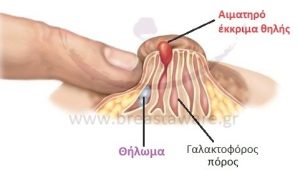Nipple Discharge: When Should You Be Concerned?
Nipple discharge is a common symptom that can cause concern, especially when it appears suddenly or affects only one breast. Although in most cases it is of benign etiology, proper evaluation by a specialist physician is essential for the prevention and early diagnosis of more serious conditions such as breast cancer.

What is nipple discharge?
It refers to the loss of fluid from the nipple duct, either with manual expression or spontaneously. It is estimated that up to 80% of women of reproductive age will experience nipple discharge at some point, and it accounts for approximately 7% of visits to Specialized Breast Clinics.
Types of discharge and their significance
The classification of nipple discharge is based on color, the composition, the mode of presentation and the number of affected ducts.
- Physiological or hormonal discharge (Galactorrhea)
It is unrelated to lactation and usually involves both breasts. The fluid is white, yellowish, brown, or clear and is secreted from multiple ducts. Possible causes:
- Medications (antidepressants, antiemetics, antihypertensives)
- Neurogenic stimulation or nipple trauma
- Endocrine disorders (hypothyroidism, prolactinoma)
The above conditions are often associated with hyperprolactinemia, meaning elevated prolactin levels in the blood.
- Lactational discharge
During pregnancy and breastfeeding, milk production is physiological. It may persist for up to 6 months after weaning. If it appears bloody discharge during this period, it is usually of benign origin due to increased vascularity of the mammary gland.
- Pathological nipple discharge
Characterized by the following features:
- Occurs only in one breast
- Originates from a single duct
- It is αυτόματο It is spontaneous (without compression)
- Έχει αιματηρή, ορώδη (διάφανη) ή έντονα χρωματισμένη μορφή (πράσινη, καφέ, κίτρινη)
In 60% of cases, it is due to intraductal papillomas, that is, benign growths within the lactiferous ducts. However, in 5-15% malignancy may be concealed malignancy, mainly in women over 40 years of age or when other suspicious symptoms are present.

When is bloody discharge concerning?
The bloody discharge discharge is associated with a higher risk of malignancy, particularly when:
- It is It is unilateral
- More spontaneously and persistently
- Is not accompanied by a palpable mass but remains persistent
Studies show that the rate of malignancy in bloody discharge reaches up to 52%, in contrast to 19% that in non-bloody discharge1.
What diagnostic tests are required?
Diagnosis is based on thorough clinical and imaging evaluation:
- Breast ultrasound (first-line test in all cases)
- Digital mammography (in women over 30 years of age)
- Blood tests (e.g., prolactin levels, TSH)
- Cytological examination or biopsy in suspicious or bloody discharges
If results are inconclusive, surgical duct excision (microdochectomy) is often recommended to rule out malignancy.
When is surgical intervention indicated?
Surgical removal is indicated when:
- There is A palpable mass is present
- Imaging reveals suspicious findings ύποπτα ευρήματα
- Το έκκριμα είναι Discharge is spontaneous, bloody, or from a single duct
In cases of breast cancer diagnosis, treatments may include lumpectomy, mastectomy, or sentinel lymph node biopsy. ογκεκτομή, μαστεκτομή ή βιοψία φρουρού λεμφαδένα.
What should I do?
If you notice nipple discharge:
- Μην το αγνοήσετεDo not ignore it, even if there is no pain or palpable mass.
- Καταγράψτε το Record the color, amount, and duration.
- Seek immediate consultation with a Specialized Breast Surgeon.
The early diagnosis Early diagnosis can lead to simple management and, in more serious cases, save lives. σώσει ζωές.
breastaware.gr is your reliable source for responsible information on symptoms, breast diseases, and breast cancer prevention. Find answers and act timely — because your breast health deserves attention.
Bibliography: :
- Tokmak A, et al. Nipple Discharge: When to Worry? Cureus. 2023;15(5):e39147. doi:10.7759/cureus.39147
- Wang S, et al. Management of Pathologic Nipple Discharge. Ann Surg Oncol. 2021;28(2):869–878. doi:10.1245/s10434-020-09068-z
- American College of Radiology. ACR Appropriateness Criteria® Nipple Discharge. 2020.
- Chae EY, et al. Clinical and Imaging Features of Nipple Discharge. AJR Am J Roentgenol. 2020;215(3):775–783. doi:10.2214/AJR.19.22536
- The Royal College of Surgeons of England. Guidelines on the Management of Nipple Discharge. 2019
